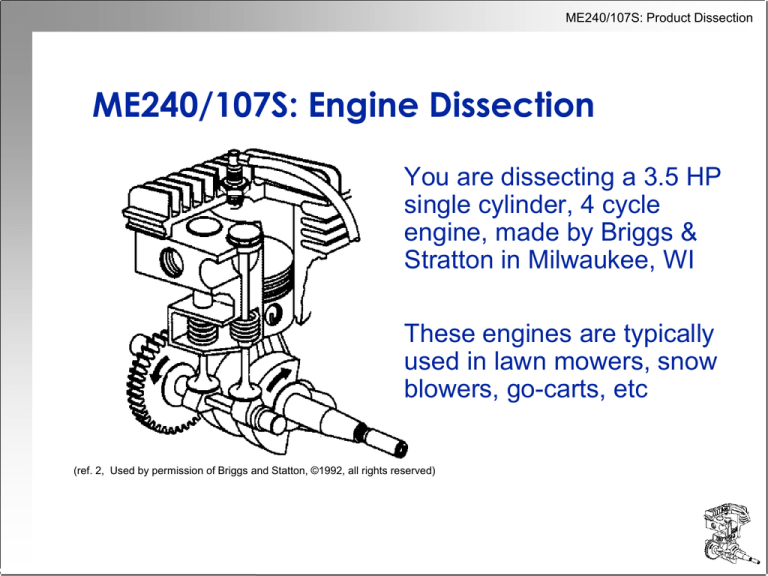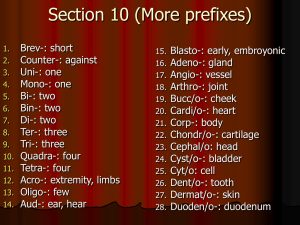
ME240/107S: Product Dissection
ME240/107S: Engine Dissection
You are dissecting a 3.5 HP
single cylinder, 4 cycle
engine, made by Briggs &
Stratton in Milwaukee, WI
These engines are typically
used in lawn mowers, snow
blowers, go-carts, etc
(ref. 2, Used by permission of Briggs and Statton, ©1992, all rights reserved)
ME240/107S: Product Dissection
Lecture 3
Material Considerations
Why Internal Combustion?
Engine Labeling Diagram
ME240/107S: Product Dissection
Session 2: Engine Block and Drivetrain
What materials are used in the camshaft?
How are the cams fastened to the shaft?
What material is used for the crankshaft?
What manufacturing processes were used
for the crankshaft, camshaft, connecting
rod, wrist pin, and piston?
What type of lubrication system does your
engine have and how does it work? Which
components receive lubrication?
ME240/107S: Product Dissection
Crankshaft
Originally steel forged;
however, large stiff
crankshafts with
relatively low stresses
allowed cast iron to be
substituted as a
means to reduce cost
How is crankshaft
supported?
ME240/107S: Product Dissection
Piston Assembly
Piston: aluminum, cast steel
or cast iron
Wrist pin: machined steel
Connecting rod: forged-steel
or cast iron
ME240/107S: Product Dissection
Cylinder Head and Crankcase
Crankcase and cylinder
block are usually cast
iron; however, some
have been assembled
from welded steel plate
Crankcase and cylinder
are usually integral for
greater rigidity
How is cylinder
head made?
Cylinder block
Crank case
ME240/107S: Product Dissection
Cylinders
How are cylinders fabricated?
Gray
cast iron with cylinder bores machined to
meet tolerance
Why must a new engine be “broken in”?
Cast
iron forms a hard glazed surface when
subject to sliding friction
When first assembled, slow speeds and light
loads should be used to facilitate forming this
protective coating to give long engine life
ME240/107S: Product Dissection
Camshaft and Cams
Camshaft and cams are
usually made from steel
In your Briggs & Stratton
engine, how is camshaft
made? How are cams
fastened?
What does the little
metal flapper do?
ME240/107S: Product Dissection
Valves
Intake valve: a
chromium-nickel
alloy
Exhaust valve: a
silicon-chrome alloy
since it operates at
higher temperatures
(about 1200oF)
ME240/107S: Product Dissection
Engine Temperature Profiles
What two
purposes
does engine
lubrication
serve?
minimize
friction
dissipate
heat
ME240/107S: Product Dissection
How does your engine lubrication
system work?
An oil pan seals
the engine block,
providing a
reservoir for
lubricating oil for
most drivetrain
components
Dip stick
Oil gallery
(for piston)
Oil gallery
Oil pan
How is oil pan
fabricated?
ME240/107S: Product Dissection
Automotive Fuel Needs
x1.1
x2.2
x2.5
After combustion and friction losses are considered, only
about 1/6 of energy available in gasoline is actually used
ME240/107S: Product Dissection
Minimizing
Losses
ME240/107S: Product Dissection
Streamlining to Reduce Air Drag
ME240/107S: Product Dissection
Why Internal Combustion?
IC engines were thought to have a bleak
future when first invented
“You can’t get people to sit over an explosion”
“The automobile industry will surely
burgeon…but this motor will not be a factor.”
- Col. Albert A. Pope, largest
automobile manufacturer at the
turn of the century
ME240/107S: Product Dissection
Why Internal Combustion?
Each group will be assigned either a steam,
electric, or internal combustion engine.
Within your group, discuss the pros/cons of
your particular type of engine based on
what you know and read in “Why IC?” article
At the end of your discussion, be prepared
to share your results with the class
ME240/107S: Product Dissection
History of IC Engines
1860 Lenoir’s
engine (a converted
steam engine)
combusted natural
gas in a double
acting piston, using
electric ignition
ME240/107S: Product Dissection
Stanley Steamer
ME240/107S: Product Dissection
History - continued
1876 Nikolaus Otto patented the 4 cycle engine;
it used gaseous fuel
1882 Gottlieb Daimler, an engineer for Daimler,
left to work on his own engine. His 1889 twin
cylinder V was the first engine to be produced in
quantities. It used liquid fuel and Venturi type
carburetor, engine was named “Mercedes” after
the daughter of his major distributor
1893 Rudolf Diesel built successful IC engine
which was 26% efficient (double the efficiency of
any other engine of its time)
ME240/107S: Product Dissection
Complementary Technologies for
IC Engine-powered Automobiles
Pneumatic tires (1888, Dunlop)
Cheap liquid fuels (Oil industry born in PA 1859)
Venturi effect carburetor (1892, Willi Maybach)
Variable mechanical transmission (primitive type
by Levassor, 1891)
Electric starter (1912 by Kettering of Cadillac)
The real end to electric cars? http://usat.ly/wRmS5K
ME240/107S: Product Dissection
Parts of an
IC Engine
Name as many
parts as you can
Your name:_________________
CROSS SECTION OF OVERHEAD VALVE FOUR CYCLE SI ENGINE




